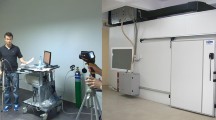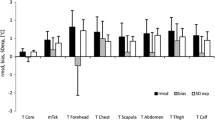Abstract
Human thermal comfort assessments pertaining to exercise while in outdoor environments can improve urban and recreational planning. The current study applied a simple four-segment skin temperature approach to the COMFA (COMfort FormulA) outdoor energy balance model. Comparative results of measured mean skin temperature (\( \mathop{{\bar{T}}}\nolimits_{{Msk}} \)) with predicted \( \mathop{{\bar{T}}}\nolimits_{{sk}} \) indicate that the model accurately predicted \( \mathop{{\bar{T}}}\nolimits_{{sk}} \), showing significantly strong agreement (r = 0.859, P < 0.01) during outdoor exercise (cycling and running). The combined 5-min mean variation of the \( \mathop{{\bar{T}}}\nolimits_{{sk}} \) RMSE was 1.5°C, with separate cycling and running giving RMSE of 1.4°C and 1.6°C, respectively, and no significant difference in residuals. Subjects’ actual thermal sensation (ATS) votes displayed significant strong rank correlation with budget scores calculated using both measured and predicted \( \mathop{{\bar{T}}}\nolimits_{{sk}} \) (r s = 0.507 and 0.517, respectively, P < 0.01). These results show improved predictive strength of ATS of subjects as compared to the original and updated COMFA models. This psychological improvement, plus \( \mathop{{\bar{T}}}\nolimits_{{sk}} \) and T c validations, enables better application to a variety of outdoor spaces. This model can be used in future research studying linkages between thermal discomfort, subsequent decreases in physical activity, and negative health trends.





Similar content being viewed by others
References
ACSM (2006) ACSM’s guidelines for exercise testing and prescription, 7th edn. Lippincott Williams and Wilkins, Philadelphia
Batte AL, Darling J, Evans J, Lance LM, Olson EI, Pincivero DM (2003) Physiologic responses to a prescribed rating of perceived exertion on an elliptical fitness cross-trainer. J Sports Med Phys Fitness 43(3):300–305
Borg GAV (1982) Psychophysical bases of perceived exertion. Med Sci Sports Exerc 14:377–381
Brotherhood JR (2008) Heat stress and strain in exercise and sport. J Sci Med Sport 11(1):6–19
Brown RD, Gillespie TJ (1986) Estimating outdoor thermal comfort using a cylindrical radiation thermometer and an energy budget model. Int J Biometeorol 30(1):43–52
Brown RD, Gillespie TJ (1995) Microclimate landscape design. Wiley, New York
Budd GM (2008) Wet-bulb globe temperature (WBGT)—its history and its limitations. J Sci Med Sport 11(1):20
Bulcao CF, Frank SM, Raja SN, Tran KM, Goldstein DS (2000) Relative contribution of core and skin temperatures to thermal comfort in humans. J Therm Biol 25(1–2):147–150
Clark R, Edholm O (1985) Man and his thermal environment. Arnold, London
Easton C, Fudge BW, Pitsiladis YP (2007) Rectal, telemetry pill and tympanic membrane thermometry during exercise heat stress. J Therm Biol 32:78–86
Epstein Y, Moran DS (2006) Evaluation of the environmental stress index (ESI) for hot/dry and hot/wet climates. Ind Health 44(3):399–403
Fanger PO (1970) Thermal comfort. Analysis and application in environmental engineering. Danish Technical, Copenhagen
Fiala D, Lomas KJ (1999) Applications of a computer model predicting human thermal comfort and responses to the design of sports stadia. In: Proceedings of CIBSE ’99. Institute of Energy and Sustainable Design, De Montfort University, Leicester, UK, p 492
Fiala D, Lomas KJ, Stohrer M (2001) Computer prediction of human themoregulatory and temperature responses to a wide range of environmental conditions. Int J Biometeorol 45:143–159
Fiala D, Lomas KJ, Stohrer M (2007) Dynamic simulation of human heat transfer and thermal comfort. In: Mekjavic S, Kounalakis S, Taylor NAS (eds) Proceedings of the 12th International Conference on Environment Ergonomics, Piran Slovenia, 17–19 August 2007, pp 513–515
Gagge AP (1971) An effective temperature scale based on a single model of human physiological temperature response. ASHRAE Trans 77:247–262
Gavhed CE, Holmer I (1996) Physiological and subjective responses to thermal transients of exercising subjects dressed in cold-protective clothing. Eur J Appl Phys Occup Phys 72(6):573–581
Golden JS, Hartz D, Brazel A, Luber G, Phelan P (2008) A biometeorology study of climate and heat-related morbidity in Phoenix from 2001 to 2006. Int J Biometeorol 52(6):471–480
Gosling S, McGregor G, Lowe J (2009) Climate change and heat-related mortality in six cities part 2: Climate model evaluation and projected impacts from changes in the mean and variability of temperature with climate change. Int J Biometeorol 53(1):31–51
Haslam RA, Parsons KC (1988) Quantifying the effects of clothing for models of human response to the thermal environment. Ergonomics 31(12):1787–1806
Havenith G, Holmer I, Parsons KC (2002) Personal factors in thermal comfort assessment: clothing properties and metabolic heat production. Energy Build 34(6):581–591
Hensel H (1981) Thermoreception and temperature regulation. Acadamic, London
Hodder SG, Parsons KC (2007) The effects of solar radiation on thermal comfort. Int J Biometeorol 51(3):233–250
Hoppe P (2002) Different aspects of assessing indoor and outdoor thermal comfort. Energy Build 34(6):661–665
Huizenga C, Hui Z, Arens E (2001) A model of human physiology and comfort for assessing complex thermal environments. Build Environ 36(6):691–699
ISO9920 (2007) ISO 9920: Ergonomics of the thermal environment: Estimation of thermal insulation and water vapour resistance of a clothing ensemble. ISO, Geneva
Johansson E, Rohinton E (2006) The influence of urban design on outdoor thermal comfort in the hot, humid city of Colombo, Sri Lanka. Int J Biometeorol 51:119–133
Karvonen M, Kentala K, Mustala O (1957) The effects of training on heart rate: a longitudinal study. Ann Exp Biol Fenn 35:307–267
Kenny NA, Warland JS, Brown RD, Gillespie TJ (2008) Estimating the radiation absorbed by a human. Int J Biometeorol 52(6):491–503
Kenny NA, Warland JS, Brown RD, Gillespie TJ (2009a) Part A: Assessing the performance of the COMFA outdoor thermal comfort model on subjects performing physical activity. Int J Biometeorol 53:415–428
Kenny NA, Warland JS, Brown RD, Gillespie TJ (2009b) Part B: Revisions to the COMFA outdoor thermal comfort model for application to subjects performing physical activity. Int J Biometeorol 53:429–441
Kenshalo DR (1970) Psychophysical studies of temperature sensitivity. In: Neff WD (ed) Contributions to sensory physiology. Academic, New York
Kerslake D (1972) The stress of hot environments. Cambridge University Press, London
Lin T (2009) Thermal perception, adaptation and attendance in a public square in hot and humid regions. Build Environ 44(10):2017–2026
Mairiaux P, Malchaire J, Candas V (1987) Prediction of mean skin temperature in warm environments. Eur J Appl Phys 56(6):686–692
Malchaire J, Kampmann B, Havenith G, Mehnert P, Gebhardt HJ (2000) Criteria for estimating acceptable exposure times in hot working environments: a review. Int Arch Occup Environ Health 73:215–220
Matzarakis A, Rutz F, Mayer H (1999) Estimation and calculation of the mean radiant temperature within urban areas. In: de Dear RJ, Potter JC (eds) Proceedings of the 15th International Congress of Biometeorology and International Conference on Urban Climatology, volume ICB9.2, pp 1–6
Maw G, Boutcher S, Taylor N (1993) Ratings of perceived exertion and effect in hot and cool environments. Eur J Appl Phys 67:174–179
Mitchell D, Wyndham CH (1969) Comparison of weighting formulas for calculating mean skin temperature. J Appl Physiol 26(5):616–622
Mora-Rodriguez R, Del Cosa J, Estevez E (2008) Thermoregulatory responses to constant versus variable-intensity exercise in the heat. Med Sci Sport Exer 40(11):1945
Morris C, Atkinson G, Drust B, Marrin K, Gregson W (2009) Human core temperature responses during exercise and subsequent recovery: an important interaction between diurnal variation and measurement site. Chronobiol Int 26(3):560–575
Munir A, Takada S, Matsushita T (2009) Re-evaluation of Stolwijk’s 25-node human thermal model under thermal-transient conditions: prediction of skin temperature in low-activity conditions. Build Environ 44(9):1777–1787
Nakamura M, Yoda T, Crawshaw LI, Yasuhara S, Saito Y, Kasuga M, Nagashima K, Kanosue K (2008) Regional differences in temperature sensation and thermal comfort in humans. J Appl Physiol 105:1897–1906
Nikolopoulou M, Baker N, Steemers K (2001) Thermal comfort in outdoor urban spaces: understanding the human parameter. Sol Energy 70(3):227–235
Nikolopoulou M, Lykoudis S (2006) Thermal comfort in outdoor urban spaces: analysis across different european countries. Build Environ 41(11):1455–1470
Ogawa T, Sugenoya J, Ohnishi N, Natsume K, Ochiai M, Nishida M, Shinoda N, Katoh K, Imamura R (1991) Dynamic sweating response of man to infrared radiation in various spectral regions. Int J Biometeorol 35(18):18–23
Parsons K (2003) Human thermal environments: The effects of hot, moderate and cold environments on human health, comfort and performance, 2nd edn. Taylor and Francis, New York
Ramanathan NL (1964) A new weighting system for mean surface temperature of the human body. J Appl Physiol 19(3):531–533
Richards M, Havenith G (2007) Progress towards the final UTCI model. In: Mekjavic S, Kounalakis S, Taylor NAS (eds) Proceedings of the 12th International Conference on Environment Ergonomics, Piran Slovenia, 19–24 August 2007, pp 521–524
Roberts WO (2007) Heat and cold: what does the environment do to marathon injury? Sports Med 37(4/5):400–403
Salloum M, Ghaddar N, Ghali K (2007) A new transient bioheat model of the human body and its integration to clothing models. Int J Therm Sci 46(4):371–384
Saltin B, Hermansen L (1966) Esophageal, rectal, and muscle temperature duirng exercise. J Appl Physiol 21:1757–1762
Shibasaki M, Wilson TE, Crandall CG (2006) Neural control and mechanisms of eccrine sweating during heat stress and exercise. J Appl Physiol 100(5):1692–1701
Spagnolo J, de Dear RJ (2003) A field study of thermal comfort in outdoor and semi-outdoor environments in subtropical Sydney Australia. Build Environ 38(5):721–738
Sparks S, Cable N, Doran D, Maclaren D (2005) The influence of environmental temperature on duathlon performance. Ergonomics 48:1558–1567
Stolwijk JAA (1971). A mathematical model of physiological temperature regulation in man. Technical report, NASA CR-1855, Washington, DC
Stolwijk JAJ, Hardy JD (1966) Temperature regulation in man—a theoretical study. Pflugers Arch Ges Physiol 291:129–162
Strath SJ, Swartz AM, Basset DR, O’Brien WL, King GA, Ainsworth BE (2000) Evaluation of heart rate as a method for assessing moderate intensity physical activity. Med Sci Sport Exer 32(9):S465–S470
Tanabe S, Kobayashi K, Nakano J, Ozeki Y, Konishi M (2002) Evaluation of thermal comfort using combined multi-node thermoregulation (65MN) and radiation models and computational fluid dynamics (CFD). Energy Build 34(6):637–646
Thorsson S, Lindqvist M, Lindqvist S (2004) Thermal bioclimatic conditions and patterns of behaviour in an urban park in Goteborg, Sweden. Int J Biometeorol 48:149–156
Tikuisis P, Meunier P, Jubenville C (2001) Human body surface area: measurement and prediction using three dimensional body scans. Eur J Appl Phys 85(3–4):264–271
Tucker R, Marle T, Lambert EV, Noakes TD (2006) The rate of heat storage mediates an anticipatory reduction in exercise intensity during cycling at a fixed rating of perceived exertion. J Physiol 574(3):905–915
van Marken Lichtenbelt WD, Frijns AJH, Fiala D, Janssen FEM, van Ooijen AMJ, van Steenhoven AA (2004) Effect of individual characteristics on a mathematical model of human thermoregulation. J Therm Biol 29(7–8):577–581
Vanos JK, Warland JS, Kenny NA, Gillespie TJ (2010) Review of the physiology of human thermal comfort while exercising in urban landscapes and implications for bioclimatic design. Int J Biometeorol 54(4):319–334
Winslow CEA, Herrington LP, Gagge AP (1936) A new method for particional calorimetry. Am J Physiol 116:641–655
Yao Y, Lian Z, Liu W, Shen Q (2007) Experimental study on skin temperature and thermal comfort of the human body in a recumbent posture under uniform thermal environments. Indoor Built Environ 16(6):505
Yao R, Li B, Liu J (2009) A theoretical adaptive model of thermal comfort—adaptive predicted mean vote (aPMV). Build Environ 44(10):2089–2096
Zhang Y, Zhao R (2008) Overall thermal sensation, acceptability and comfort. Build Environ 43:44–50
Zhang H, Huizenga C, Arens E, Wang D (2004) Thermal sensation and comfort in transient non-uniform thermal environments. Eur J Appl Physiol 92:728–733
Zolfaghari A, Maerefat M (2010) A new simplified model for evaluating non-uniform thermal sensation caused by wearing clothing. Build Environ 45:776–783
Author information
Authors and Affiliations
Corresponding author
Rights and permissions
About this article
Cite this article
Vanos, J.K., Warland, J.S., Gillespie, T.J. et al. Thermal comfort modelling of body temperature and psychological variations of a human exercising in an outdoor environment. Int J Biometeorol 56, 21–32 (2012). https://doi.org/10.1007/s00484-010-0393-2
Received:
Revised:
Accepted:
Published:
Issue Date:
DOI: https://doi.org/10.1007/s00484-010-0393-2




